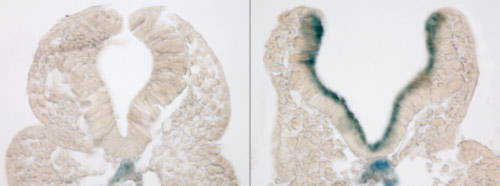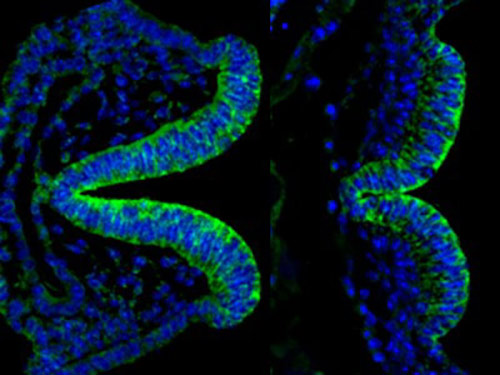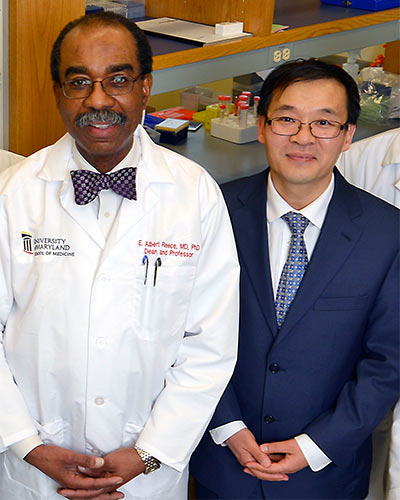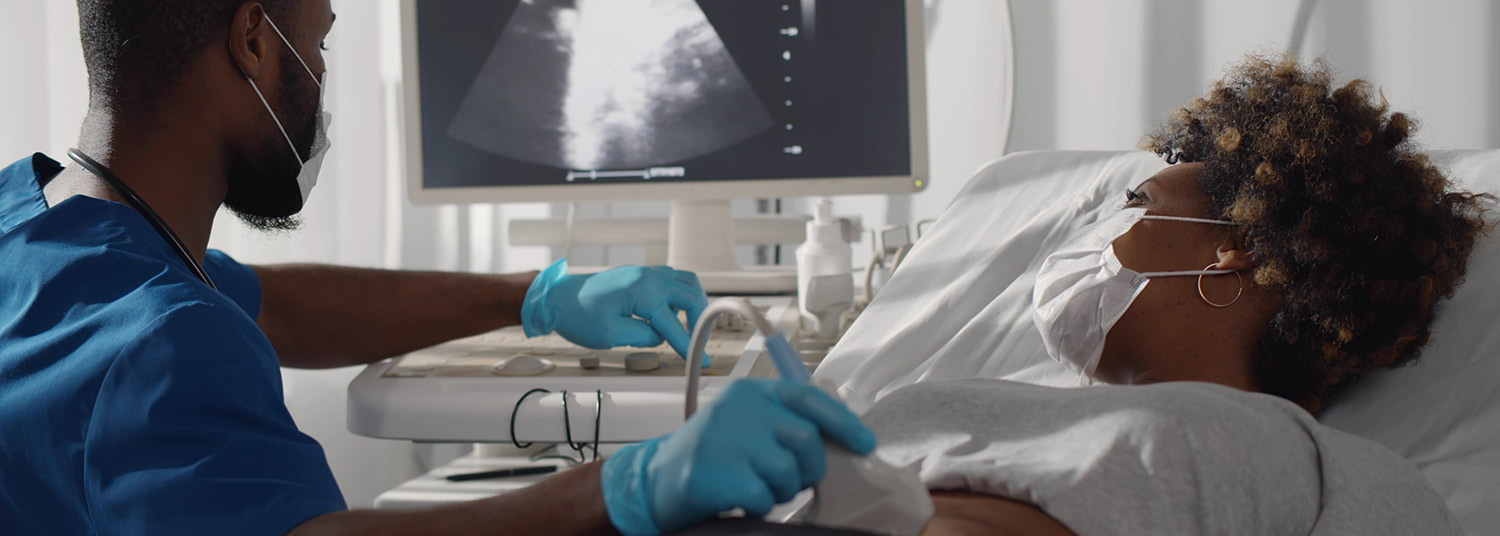September 09, 2021 | Vanessa McMains
Findings suggest that treatments could be developed to prevent miscarriages and certain birth defects in babies
More than 3 million women of birthing age in the U.S. and 60 million in the world have diabetes—a disease that occurs when blood sugar is too high. Even when controlled with insulin, and blood sugar levels are kept mostly in check, maternal diabetes can cause permanent damage to the fetus. About 300,000 to 400,000 fetuses per year from mothers with diabetes develop neural tube defects—when the tissue that eventually forms the brain and spinal cord fails to form properly—which can lead to miscarriage or profound disability.

The study, published on June 30 in Science Advances, was conducted by the UMSOM Center for Birth Defects Research, led by Peixin Yang, PhD, Professor of Obstetrics, Gynecology and Reproductive Sciences, Director of the Center for Birth Defects Research, and Vice Chair of Research in the Department, and E. Albert Reece, MD, PhD, MBA, Executive Vice President for Medical Affairs, UM Baltimore, and the John Z. and Akiko K. Bowers Distinguished Professor and Dean of UMSOM.
“Although diabetes is a disease generally associated with an older population, the modern diabetes epidemic in young people is largely fueled by obesity and inactivity. At the same time, many aging-related diseases are impacted by diabetes, and we now know that high blood glucose seems to induce or enhance premature embryonic aging,” said Dr. Yang. “For many decades, our hypothesis was that premature aging, known as senescence, was occurring in the fetuses of mothers with diabetes, and was, in part, inducing these birth defects. It was only recently that we have had the tools and technology to be able to test our hypothesis.”

Their findings suggest that more specialized therapies could be developed to prevent miscarriages or birth defects in babies born from mothers with diabetes.

Next, the researchers treated the mouse pups from mothers with diabetes with the cancer drug rapamycin, known to prevent the toxic chemical signals from being released by the prematurely aging cells. They found that mouse pups treated with rapamycin had neural tubes that were fully formed like those found in pups born from mothers without diabetes.
“This drug essentially made the senescent cells behave normally,” said Dr. Yang. Unfortunately, rapamycin affects too many other cell processes and can be toxic, so it would not be a viable treatment for preventing neural tube defects in human infants.

Additional authors include Cheng Xu, PhD, Research Associate in the Department of Obstetrics, Gynecology and Reproductive Sciences; Wei-Bin Shen, PhD, Assistant Professor of Obstetrics, Gynecology and Reproductive Sciences and Christopher Harman, MD, the Sylvan Frieman, MD Endowed Professor and Chair in Obstetrics, Gynecology & Reproductive Sciences at UMSOM, along with Sunjay Kaushal of Ann & Robert H. Lurie Children’s Hospital of Chicago, and Hidetoshi Hasuwa of Keio University.
This research was supported by several grants funding by the National Institutes of Health and Eunice Kennedy Shriver National Institute of Child Health and Human Development (NICHD):
(HD100195, R01HD102206, R01HD099843), National Institute of Diabetes and Digestive and Kidney Diseases (NIDDK) (R01DK083243, R01DK101972, R01DK103024), and National Heart, Lung, and Blood Institute (NHLBI) (R01HL131737, R01HL134368, R01HL139060).
About the University of Maryland School of Medicine
Now in its third century, the University of Maryland School of Medicine was chartered in 1807 as the first public medical school in the United States. It continues today as one of the fastest growing, top-tier biomedical research enterprises in the world -- with 46 academic departments, centers, institutes, and programs, and a faculty of more than 3,000 physicians, scientists, and allied health professionals, including members of the National Academy of Medicine and the National Academy of Sciences, and a distinguished two-time winner of the Albert E. Lasker Award in Medical Research. With an operating budget of more than $1.2 billion, the School of Medicine works closely in partnership with the University of Maryland Medical Center and Medical System to provide research-intensive, academic and clinically based care for nearly 2 million patients each year. The School of Medicine has nearly $600 million in extramural funding, with most of its academic departments highly ranked among all medical schools in the nation in research funding. As one of the seven professional schools that make up the University of Maryland, Baltimore campus, the School of Medicine has a total population of nearly 9,000 faculty and staff, including 2,500 students, trainees, residents, and fellows. The combined School of Medicine and Medical System (“University of Maryland Medicine”) has an annual budget of over $6 billion and an economic impact of nearly $20 billion on the state and local community. The School of Medicine, which ranks as the 8th highest among public medical schools in research productivity (according to the Association of American Medical Colleges profile) is an innovator in translational medicine, with 606 active patents and 52 start-up companies. In the latest U.S. News & World Report ranking of the Best Medical Schools, published in 2021, the UM School of Medicine is ranked #9 among the 92 public medical schools in the U.S., and in the top 15 percent (#27) of all 192 public and private U.S. medical schools. The School of Medicine works locally, nationally, and globally, with research and treatment facilities in 36 countries around the world. Visit medschool.umaryland.edu
Contact
Vanessa McMains
Director, Media & Public Affairs
University of Maryland School of Medicine
Institute of Human Virology
vmcmains@ihv.umaryland.edu
Cell: 443-875-6099
Related stories

Wednesday, February 21, 2024
UMSOM and UMB Faculty Receive $10.6 Million in State Funding for Abortion Clinical Care Training Program
A $10.6 million training grant has been awarded to the University of Maryland School of Medicine (UMSOM) and University of Maryland, Baltimore (UMB) to administer Maryland’s Abortion Clinical Care Training Program. The grant will be used to expand the number of healthcare professionals with abortion care training, increase the racial and ethnic diversity among health care professionals with abortion care education, and support the identification of clinical sites needing training.

Monday, December 10, 2018
As Health Threats of the Diabetes-Obesity Epidemic Increase, Two Leading OB-GYN and Maternal-Fetal Medicine Experts Publish New Book on Diabetes and Obesity in Women
With diabetes and obesity continuing to escalate at alarming rates in the U.S., particularly among women, a new book has been published that provides the most comprehensive, expert coverage of this urgent topic to date.

Wednesday, August 09, 2017
UM SOM Names Deputy Director of Graduate and Postdoctoral Studies for its Graduate Program in Life Sciences
Dudley K. Strickland, PhD, Associate Dean for Graduate and Postdoctoral Studies at the University of Maryland School of Medicine (UM SOM), along with UM SOM Dean E. Albert Reece, MD, PhD, MBA, announced that Peixin Yang, PhD, Professor of Obstetrics, Gynecology and Reproductive Sciences (OB-GYN), has been named Deputy Director of Graduate and Postdoctoral Studies in UM SOM’s Graduate Program in Life Sciences (GPILS).

Friday, May 12, 2017
University of Maryland School of Medicine Researchers Identify Gene That Controls Birth Defect Common in Diabetes
Researchers at the University of Maryland School of Medicine (UM SOM) have identified a gene that triggers a process leading to the formation of neural tube defects, a problem commonly found in infants of pregnant women with diabetes. This is the first time the gene has been shown to play this role; it opens up a new way to understand these defects, and may one day lead to new treatments that could prevent the problem or decrease its incidence.

